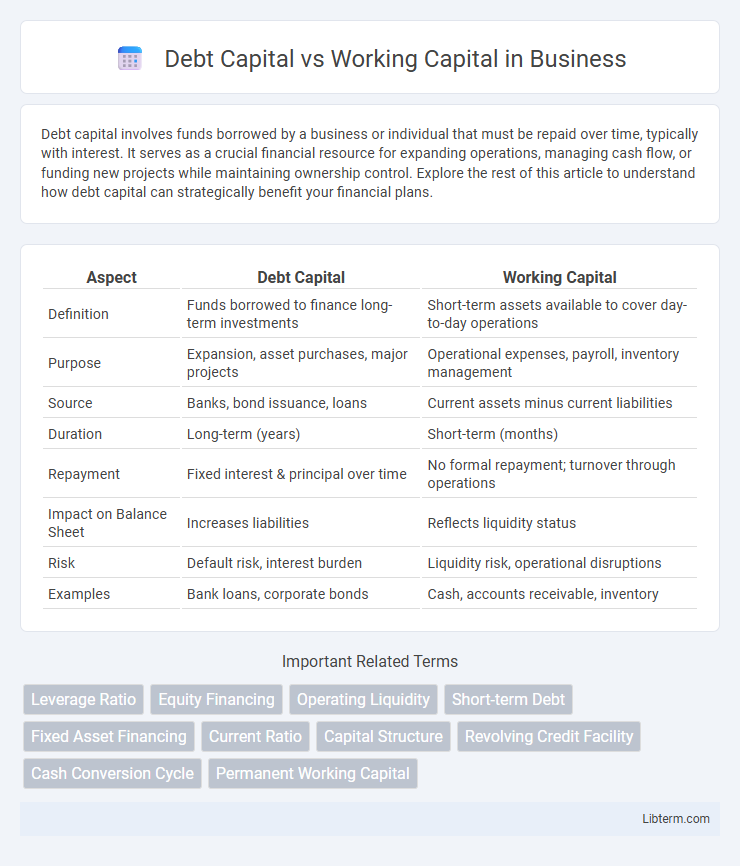Debt capital involves funds borrowed by a business or individual that must be repaid over time, typically with interest. It serves as a crucial financial resource for expanding operations, managing cash flow, or funding new projects while maintaining ownership control. Explore the rest of this article to understand how debt capital can strategically benefit your financial plans.
Table of Comparison
| Aspect | Debt Capital | Working Capital |
|---|---|---|
| Definition | Funds borrowed to finance long-term investments | Short-term assets available to cover day-to-day operations |
| Purpose | Expansion, asset purchases, major projects | Operational expenses, payroll, inventory management |
| Source | Banks, bond issuance, loans | Current assets minus current liabilities |
| Duration | Long-term (years) | Short-term (months) |
| Repayment | Fixed interest & principal over time | No formal repayment; turnover through operations |
| Impact on Balance Sheet | Increases liabilities | Reflects liquidity status |
| Risk | Default risk, interest burden | Liquidity risk, operational disruptions |
| Examples | Bank loans, corporate bonds | Cash, accounts receivable, inventory |
Understanding Debt Capital
Debt capital refers to funds borrowed by a business to finance operations, investments, or expansion, usually through loans, bonds, or lines of credit. It requires repayment with interest and is recorded as a liability on the balance sheet, impacting a company's leverage and creditworthiness. Understanding debt capital involves assessing borrowing costs, debt covenants, and the impact on cash flow to maintain financial stability and support growth strategies.
Defining Working Capital
Working capital represents the difference between a company's current assets and current liabilities, reflecting its short-term liquidity and operational efficiency. It is essential for financing daily business operations such as inventory management, payroll, and accounts payable. Unlike debt capital, which involves borrowed funds used for long-term investments, working capital focuses on maintaining smooth operational cash flow and supporting immediate financial obligations.
Key Differences Between Debt Capital and Working Capital
Debt capital represents long-term funds borrowed to finance major investments, typically sourced through loans or bonds, and requires scheduled repayments with interest. Working capital reflects the short-term liquidity available for daily operations, calculated as current assets minus current liabilities, ensuring smooth business functioning. The key differences lie in purpose, duration, and financial impact: debt capital funds growth or expansion over an extended period, while working capital manages immediate operational expenses and cash flow.
Sources of Debt Capital
Sources of debt capital primarily include bank loans, corporate bonds, commercial papers, and trade credit, each offering different terms and maturity periods suited to business needs. Bank loans provide long-term financing with fixed interest rates, while corporate bonds allow companies to raise significant capital from investors in the public market. Commercial papers and trade credit offer short-term funding options, with commercial papers typically issued by large corporations and trade credit extended by suppliers.
Components of Working Capital
Working capital primarily consists of current assets and current liabilities, including components such as cash, accounts receivable, inventory, accounts payable, and short-term debt. Effective management of working capital ensures sufficient liquidity for day-to-day operations, contrasting with debt capital, which refers to long-term borrowing used for major investments or expansion. Unlike debt capital, working capital components are constantly cycled through business activities to support operational efficiency and cash flow stability.
Advantages and Disadvantages of Debt Capital
Debt capital offers the advantage of retaining ownership control since it does not dilute equity, while providing tax benefits through interest expense deductions. However, the obligation to meet fixed interest payments can strain cash flow, increasing financial risk during downturns. Excessive reliance on debt capital may lead to higher credit risk and potential insolvency if earnings are insufficient to cover debt servicing costs.
Benefits and Challenges of Working Capital Management
Working capital management ensures a company maintains sufficient liquidity to meet short-term obligations and operational expenses, enhancing cash flow and operational efficiency. Effective working capital management reduces the risk of insolvency and can optimize inventory levels, receivables, and payables, contributing to improved profitability. Challenges include balancing the trade-off between liquidity and profitability, managing unpredictable cash flows, and avoiding over-investment in current assets that may limit growth potential.
Impact of Debt Capital on Business Operations
Debt capital significantly influences business operations by providing immediate funds for expansion, equipment purchase, or inventory acquisition. While it can improve cash flow and operational capacity, excessive debt increases financial risk through interest obligations and repayment pressure. Effective debt management is crucial to maintain operational stability and avoid liquidity crises.
Strategies to Optimize Working Capital
Optimizing working capital involves improving cash flow management, accelerating accounts receivable collections, and extending accounts payable terms to maintain liquidity. Implementing inventory management techniques such as Just-In-Time (JIT) reduces holding costs and frees up capital tied in stock. Leveraging technology platforms for real-time financial monitoring enhances decision-making and minimizes the risk of cash shortfalls, ensuring efficient use of debt capital alongside operational resources.
Choosing Between Debt Capital and Working Capital for Business Growth
Choosing between debt capital and working capital for business growth depends on the company's financial structure and cash flow needs. Debt capital, sourced from loans or bonds, provides a lump sum for long-term investments and expansion but requires regular interest payments and can increase financial risk. Working capital, derived from current assets minus current liabilities, ensures day-to-day operational efficiency and liquidity, making it essential for sustaining short-term business activities and supporting growth without incurring debt.
Debt Capital Infographic

 libterm.com
libterm.com